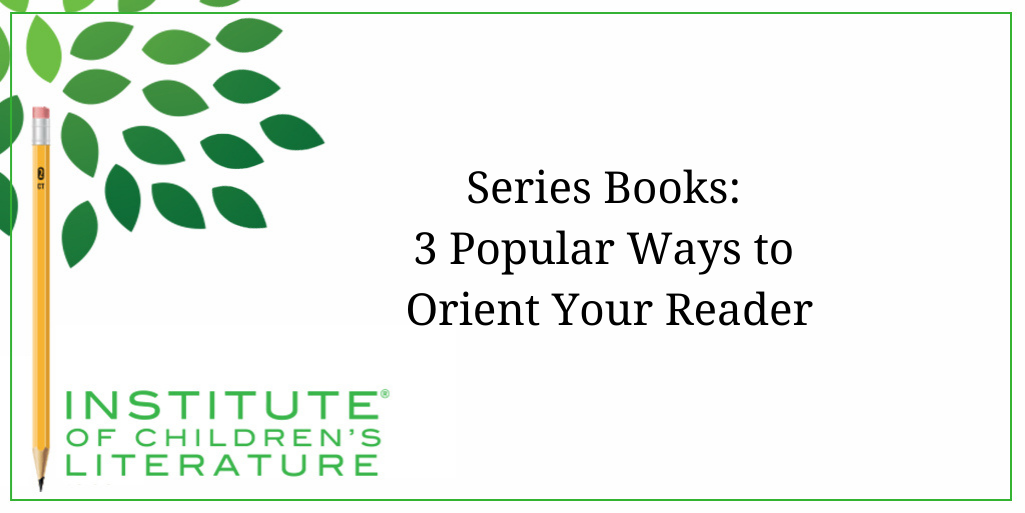
5 Ways Writers Can Prep for 2025 Goal Setting
Before we roll on to the new writing year, let’s harness our optimism for the blank slate before us and prepare for our 2025 Goal Setting just for writers.

One of the key elements of series books is that not every reader will have the opportunity to read series books in order. This is especially true in a long series where the first books may be difficult to get hold of. Also, even if a reader reads every book in perfect order, if time passes between books in a series, it can be easy to forget elements of the premise and characters. Because of this, each book in a series must somehow orient your reader to what is going on in the series overall and the specific book in hand. This helps prevent confusion.
Confusion is the enemy of any children’s writer, as a confused reader is a frustrated reader. And a frustrated reader will stop reading. This orientation is usually accomplished either all at once or in bits. Let’s look at three ways to orient your reader.
One way to orient your reader is to use some kind of boilerplate text that opens the book, much like a prologue, and doesn’t change much from book to book. It recaps the premise and introduces the main characters.

The negative side of boilerplate is that it works best in episodic series. For example, if the series is about a teenaged group of ghost hunters who spend their weekends visiting haunted houses, a boilerplate will tend to be fine because each book will basically be more scary adventures in haunted houses. You won’t have progressive information added that changes the boilerplate. In a series that follows characters in very changing circumstances, a boilerplate works less well because the new reader needs to know more than the premise, they need to know all the highlights of what has come before. The past information the reader needs changes in every book.
The needs of a progressive series doesn’t mean you cannot open each book with an orienting passage. It does mean the passage cannot be an unchanging boilerplate, because new things need to be shared. Some authors choose to handle this in much the same way television series do—with an opening that tells us all the key elements of what came before. On television programs, this kind of recap often opens with “previously on….”
Books can basically do same thing to orient your reader. For example, an extreme version of a “previously on” recap happens at the beginning of Along the Saltwise Sea, the second book of the Up-and-Under Series by A. Deborah Baker. In this book, the recap of the first book is pages and pages long and written in a very fairy tale style. It basically retells the entire plot of that first book, condensing it through this fairytale style that is all telling and no showing. This is a risky choice. The fairy tale style is a little slow moving and can be wordy, and if the reader read the first book, it runs the risk of being very boring. It also runs a risk by its very familiarity of making the child think, “I read this book already” because the fairy tale style recap isn’t set apart like a prologue. In fact, there is nothing to suggest it’s a recap and not simply how this story is going to be told. It’s definitely risky, and unusual. Most “previously on” recaps are much more condensed, only hit the high points, and are presented in some way that makes it clear it’s not part of the main narrative.
I’ve seen such recaps done as secret files discovered years later, for instance. Or newspaper accounts. Or letters. The different structure helps the recap look different and the fact that it’s a different style from the rest of the book is explained by it being a file, a newspaper story, or a police interview transcript or a letter or a journal entry. All kinds of different unusual styles have been used for this.
Another, really popular, way of handling orienting is simply to break up the things the reader needs to know and sprinkle them throughout the first chapter. It is often presented in action, in dialogue, or in inner monologue. Let’s look at some ways this might work. For an information scrap given through inner monologue, consider this excerpt from our imagined ghost hunters series and think about what bits are there to orient your reader:
Carrie stared up at the tall Victorian. The house would be sad even if she didn’t know its past, simply because it had clearly once been beautiful before neglect and time had brought rot and destruction. Now it stank, and Carrie’s stomach roiled as she tried to force herself forward. This isn’t my first haunted house. Or my second, or even my tenth. I have a job here. I need to get hold of myself and do it. The team is counting on me.
Now let’s orient the reader a little more in dialogue and action.
A thump on her back made Carrie jump and shriek. She spun to give Joel the evil eye. “Don’t sneak up on me.”
“You know I don’t sneak, baby sister,” Joel said. “Now are you going to carry some of this gear? Being our medium doesn’t get you out of pack mule duty.” He handed over a heavy bag, one she knew held mostly cameras.

If you chose to inject your orienting information into the story in bits and pieces, do it inside a scene whenever possible so the reader is so caught up in the moment that the bits of information being handed out doesn’t slow things down or bore.
Series books always need some kind of orienting for the sake of new readers jumping in, or old readers rejoining the series after a break. Readers may have read a lot of books before coming back to the series, so orienting can help make each book interesting right from the beginning.
For this orienting process, some writers use a clear introduction. Some use bits and pieces. And some do both, using boilerplate to introduce the premise and characters and bits of information to let the reader know about ways the characters have changed through the series. It’s a delicate balance as you never want to bore the reader. You need to keep the book interesting and engaging. It’s only confusion that you’re trying to avoid. So you won’t need to tell the reader everything. And for everything you tell, do it in a lively way and the information will add to the scenes rather than distract from them. It’s challenging, but then so is everything about writing. And as with all the rest, it’s worth the effort.
With over 100 books in publication, Jan Fields writes both chapter books for children and mystery novels for adults. She’s also known for a variety of experiences teaching writing, from one session SCBWI events to lengthier Highlights Foundation workshops to these blog posts for the Institute of Children’s Literature. As a former ICL instructor, Jan enjoys equipping writers for success in whatever way she can.

Before we roll on to the new writing year, let’s harness our optimism for the blank slate before us and prepare for our 2025 Goal Setting just for writers.

Writers can be thin-skinned when it comes to getting feedback on their work. Let’s look at 4 ways to positively deal with constructive criticism!

Rejection is part of the territory when it comes to being a writer. Today we offer reflection for writers to help redirect your efforts after a rejection.
1000 N. West Street #1200, Wilmington, DE 19801
© 2024 Direct Learning Systems, Inc. All rights reserved.
1000 N. West Street #1200, Wilmington, DE 19801
© 2024 Direct Learning Systems, Inc. All rights reserved.
1000 N. West Street #1200, Wilmington, DE 19801
© 2024 Direct Learning Systems, Inc. All rights reserved.
1000 N. West Street #1200, Wilmington, DE 19801
© 2024 Direct Learning Systems, Inc. All rights reserved.

1000 N. West Street #1200, Wilmington, DE 19801
© 2025 Direct Learning Systems, Inc. All rights reserved.

1000 N. West Street #1200, Wilmington, DE 19801
©2025 Direct Learning Systems, Inc. All rights reserved. Privacy Policy.
1 Comment